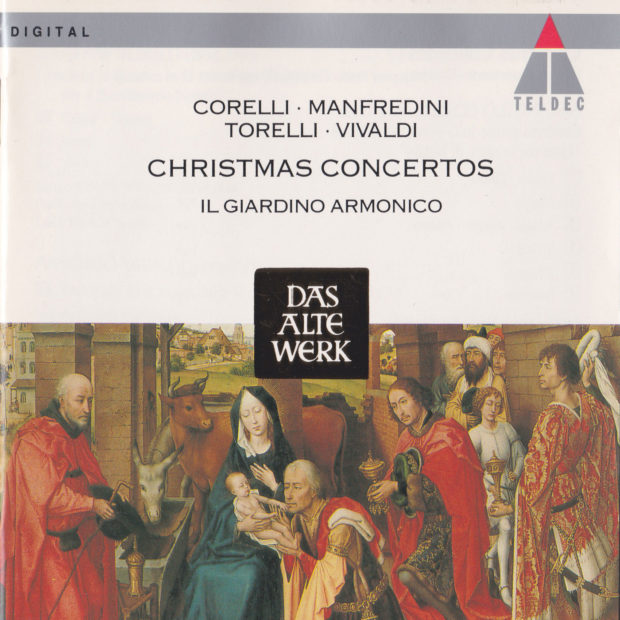The sentimental and idyllic picture generally summoned up by Christmas concerti, especially those of the Baroque period, does not altogether reflect musical reality in Italy. Whereas today’s listener imagines joyful music composed in a pious time, the musical landscape portrayed in the concerti of the Italian Baroque composers was altogether richer and more colourful. This can be seen from the selection of Baroque concerti on this disc, which were either written directly for Christmas celebrations, or — as in the case of the concerto by Pez — could be used as Christmas music. A look at the works produced by two generations of Italian composers in Venice, Bologna and Rome around 1700 reveals great diversity in the concerto genre, with a wealth of different forms, musical technique and melodic inspiration that certainly deserve the name ‘Baroque’ (Italian barocco— literally ornate, irregular).
At the beginning of this tradition stands Arcangelo Corelli (1653-1713), who was equally important as a composer and a violinist. He is represented here by the eighth Concerto grosso from his opus 6, which was composed for Christmas night (“Fatto per la notte di Natale”). Corelli probably wrote this concerto in 1690 for the young Cardinal Pietro Ottoboni, his most important patron in Rome. The complete set of twelve Concerti grossi op.6 did not appear in print until 1714 in Amsterdam, a year after the composer’s death, and they then served to establish Corelli’s fame throughout Europe. A slightly younger contemporary of Corelli was Giuseppe Torelli (1658-1709), whose Concerti grossi con una Pastorale per il Santissimo Natale were likewise published posthumously, albeit in the year of Torelli’s death, when they appeared in Bologna as his opus 8. Torelli began his career in Bologna, where he was accepted as a member of the prominent Accademia filarmonica in 1684, fourteen years after Corelli; after spending five years abroad, he returned to Bologna for the rest of his days. The sixth of his twelve concerti op.8 consists of three movements, fast-slow-fast in accordance with the model of the Neapolitan overture; the slow movement is a Pastorale. One of the violin virtuoso Torelli’s pupils in Bologna was Francesco Manfredini (1684-1762), who worked as a violinist and composer in a variety of north Italian towns before returning to his native Pistoia in 1727 as Maestro di cappella of the Cathedral there. The last (no.12) of his opus 3 set of Concerti, which were published in Bologna in 1718, is shown by the title “per il Santissimo Natale” and by the opening Pastorale to be a Christmas concerto that owes a good deal to the model of the Torelli concerto.
Of the two works by Antonio Vivaldi (1678-1741) recorded here, only the concerto entitled II riposo/per il Natale definitely comes from his pen. The set of six sonatas op.13 which were published in Paris in 1737 – the sixth, solo sonata bears the title Pastorale – cannot be attributed to the Venetian master with complete certainty. As a solo concerto, Vivaldi’s Christmas concerto is differently scored from the Concerti grossi of the
Bolognese school. The concertante dialogue between the violin and the orchestra and the alternation of ritornelli and solo sections display the clarity and elegance and the transparent structure that gave Vivaldi his considerable reputation.
The traditional background to the Pastorale movements was the Christmas music-making of the pifferari and zampognari (the piffero was a shawm, the zampogna a kind of bagpipe), i.e. shepherds who played in Italian towns at Christmas time in remembrance of the shepherds of Bethlehem. Typical recurring features of this music are the thirds melodies, the burden bass and the gently swaying siciliano rhythm – elements that were subsequently absorbed into the genre of the pastorale. The “oddman-out” in this collection is the German composer Johann Christoph Pez (1664-1716), whose concerto has nothing to do with the Italian pastorale tradition, in spite of its two pastorale movements. The Pez work should be seen against the background of the galant shepherd games popular in courtly circles in the Baroque period. The shepherds referred to in this concerto, then, are not the Biblical shepherds with their music, but rather the frolicking shepherds and shepherdesses of bucolic poetry.
Matthias Hutzel
We know next to nothing about Pietro Antonacci, neither where nor when he lived. The manuscript of his only surviving work, the Sinfonia Pastorale, is in the library of the Conservatorio Giuseppe Verdi in Milan; it belongs to the “Noseda” collection, which contains many Neapolitan compositions. The sonata was probably written around 1770: the same stylistic features that suggest this date also indicate that Pietro Antonacci may well be the same person as one Petro Antonacci Hieronimo. There is a memorial tablet to a man of this name in the church of Santa Maria delle Grazie a Montesanto in Naples, bearing the inscription printed below. The memorial is by the altar to St. Cecilia, near the tomb of Alessandro Scarlatti.
D.O.M.
Divaeque Ceciliae Tutelari suae
Diu dicatum Altare sacellumque
Musicorum chorus Aedis Reggi Palatii
Sibi proprium
Auctore Paschale Capharo
Regiarum Maiestatum Magistro
Et primo eiusdem aedis chorago
Aere collato exornarunt
Anno MDCCLXXVII
Curantibus Petro Antonacci Hieronimo
De Donato et Jochimo Sabbatino
Annuis praefectis.
In the honour of Our Lord the supreme God
And of Cecilia, their patron saint,
This altar, consecrated many years ago,
And the chapel were embellished
With contributions collected
In the year 1777
By the choir and the musicians of the church
of Reggio Palatio,
Directed by Paschal Capharo,
Teacher to Their Royal Highnesses
And first choirmaster of this church,
Under the supervision of Petro Antonacci
Hieronimo
De Donato and Jochimo Sabbatino,
The church elders in this year.
Lorenzo Ghielmi
Translations: Clive Williams

